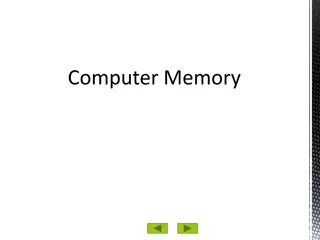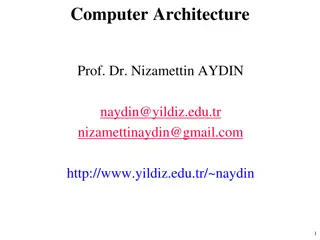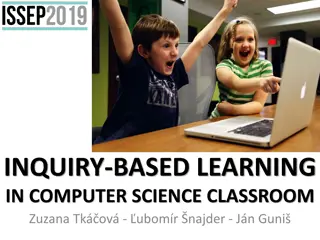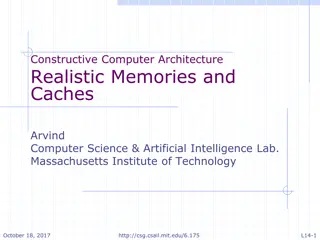Understanding Computer Organization and Architecture
A computer system is a programmable digital electronics device that processes data as per program instructions to provide meaningful output. It comprises hardware and software components, with hardware being the physical parts and software essential for driving the hardware. Computer organization fo
14 views • 71 slides
Efficient Planning for Electric School Bus Implementation
Prepare for the transition to electric school buses by focusing on team collaboration, strategic planning, and effective communication. Understand route details, battery capacity, and charging infrastructure requirements. Collaborate with utilities, optimize charging schedules, and ensure seamless i
2 views • 18 slides
Foothill Transit Electric Bus Program Overview
Foothill Transit's electric bus program, led by Roland Cordero, Director of Maintenance & Vehicle Technology, has made significant strides since its inception. With a focus on innovation and sustainability, the program has deployed a fleet of fast-charge and extended-range electric buses across vari
3 views • 17 slides
Understanding Computer Memory Fundamentals
Memory in computers is essential for storing and processing data. It is composed of semiconductor switches that represent binary numbers as 0s and 1s. This article covers the basics of memory, including bits, ROM, and RAM, explaining their functions and significance in a computer system. It also dis
12 views • 44 slides
Introduction to Components of a Computer System in Home Science
Explore the components of a computer system in Home Science, including input devices like the keyboard, alphanumeric keypads, cursor movement keys, and special keys such as Enter, Ctrl, Esc, and more. Learn about the internal structure of a computer system and the key functions of CPU, ALU, memory,
9 views • 12 slides
GDS System
Travelopro Global Distribution System (GDS) is a computerized network system. It is a large computer network which is integrated with 100 of worldwide Airlines and consolidators for enabling transactions between travel agents and travel sites and also used by airlines, hotels, car rentals, railways
4 views • 15 slides
NYSBIP Webinar Series: Clean Transportation Progress Summary
Progress towards transitioning school buses in New York State to electric vehicles is highlighted in the NYSBIP webinar series. Updates on the current conditions, program changes, and voucher redemption training are discussed, emphasizing the goal of having 3,000 electric buses on the road by 2027.
0 views • 11 slides
Overview of Computer Hardware Components and Software Functions
Computer hardware components such as monitor, CPU, mouse, and projector are essential physical parts of a computer system, while software includes intangible programs like operating systems and utility software. Hardware components perform tasks like displaying data, processing information, and prin
8 views • 9 slides
Understanding Computer Architecture: CPU Structure and Function
Delve into the intricate world of computer architecture with Prof. Dr. Nizamettin AYDIN as your guide. Explore topics such as CPU structure, registers, instruction cycles, data flow, pipelining, and handling conditional branches. Gain insights into the responsibilities of a CPU, internal structures,
0 views • 39 slides
Drive Clean Truck Incentive Program Details
Drive Clean Truck initiative in Chicago offers point-of-sale incentives to move fleets towards zero and low-emission vehicles, focusing on Class 2 to Class 8 trucks and buses. The program, funded by the Chicago Department of Transportation and administered by CALSTART, issued $11.3M for 288 trucks a
0 views • 9 slides
Understanding Computer Architecture and Organization
Computer architecture and organization are fundamental aspects of computing systems. Computer architecture focuses on the functional design and implementation of various computer parts, while computer organization deals with how operational attributes come together to realize the architectural speci
3 views • 40 slides
Understanding Computer System and Organization
Computer Organization involves the logical structure of a computer, defining the interconnections of components for optimal performance. Computers process data through an Input-Process-Output cycle, with input, processing, and output units working together. The characteristics of a computer include
1 views • 20 slides
Understanding Computer System Buses: Components and Functions
A computer system comprises three main components - the CPU, memory unit, and I/O devices connected via an interconnection network, facilitated by the system bus. System buses reduce communication pathways, enabling high-speed data transfer and synchronization between components. Internal buses conn
3 views • 55 slides
Computer Science Department Information and Courses Offered
The Computer Science Department provides information on courses offered for GCSE or BTEC qualifications, specifically focusing on the AQA GCSE in Computer Science. The course equips students with valuable thinking and programming skills essential in the modern workplace, covering key concepts and pr
3 views • 7 slides
Anatomy of a Computer System: Hardware Components and Functions
A typical computer system consists of hardware and software working together to perform various computational tasks. The hardware components include the central processing unit (CPU), input/output devices, storage units, and the motherboard. The CPU acts as the main brain of the computer, performing
6 views • 6 slides
Understanding Computer Processing Systems
Computer processing systems consist of various components such as the control unit, ALU, input unit, CPU, output unit, memory, and more. Input devices feed raw data to the computer, while output devices provide processed information. The CPU plays a crucial role in executing instructions and data pr
0 views • 13 slides
**Exploring Inquiry-Based Learning in Computer Science Education**
Inquiry-based learning (IBL) in computer science classrooms focuses on fostering communication, collaboration, decision-making, and problem-solving skills among students. The approach involves students constructing knowledge through independent, active activities based on real-world experiences. How
0 views • 18 slides
Understanding the Functional Blocks of the 8086 Microprocessor
The 8086 Microprocessor is a pivotal component in computer systems, with various functional blocks storing results as status bits called flags in the flag register. It performs arithmetic and logic operations, utilizes registers for data storage, features an ALU for generating addresses and instruct
3 views • 41 slides
Evolution of Algorithms and Computer Science Through History
The history of algorithms and algorithmic thinking dates back to ancient times, with the development of general-purpose computational machines by Charles Babbage in the 19th century marking a significant advancement. The term "computer science" emerged in 1959, encompassing theoretical computer scie
1 views • 39 slides
Constructive Computer Architecture Realistic Memories and Caches
Explore the realm of constructive computer architecture, realistic memories, and cache systems as presented by the Computer Science & Artificial Intelligence Lab at Massachusetts Institute of Technology. Delve into topics like 2-stage pipeline, magic memory models, and memory system views to gain in
0 views • 20 slides
Evolution of Buses: From Horse-Drawn to High-Tech
Buses have come a long way since their inception in the early 19th century, transitioning from horse-drawn carriages to modern, specialized vehicles like school buses, luxury motorcoaches, and double-deckers. The timeline of bus development includes the introduction of steam, electric, and internal
0 views • 9 slides
Overview of Buses and Motor Coaches in Tourism Transport
This content provides an introduction to buses and motor coaches in tourism transport, discussing different types of vehicles like buses, motor coaches, minibusses, and trolleybuses. It also delves into the various services offered, including regular, special regular, and occasional services. Moreov
0 views • 11 slides
Overview of Computer Input and Output Devices
Input devices of a computer system consist of external components like keyboard, mouse, light pen, joystick, scanner, microphone, and more, that provide information and instructions to the computer. On the other hand, output devices transfer information from the computer's CPU to the user through de
0 views • 11 slides
Understanding Diesel Engine Emissions Control Systems in Transit Buses
This educational material focuses on the operations and components of diesel engine emissions control systems, specifically DOC with DPF systems in transit buses. Learn about the role of exhaust after-treatment, dosing valve injector, diesel oxidation catalyst, and diesel particulate filter. Explore
0 views • 45 slides
Understanding Computer Graphics: An Overview
Computer graphics involves creating images and animations using a computer through hardware and software systems. It has evolved significantly over the years, with advancements in generating various types of computer graphics. Learn about the basics of computer graphics, including digital image repr
0 views • 15 slides
Understanding Computer Crimes and Prevention Strategies
Computer crimes involve illegal acts utilizing computer systems, leading to various consequences. This lecture covers the types of computer system attacks, motives behind computer crimes, costs, prevention strategies, and reflection on the discussed topics. It emphasizes the increasing scope of comp
1 views • 20 slides
Understanding System on Chip (SoC) Design and Components
Explore the world of System on Chip (SoC) design, components, and working flow. Learn about Intellectual Properties (IP), platform-based design, typical design flows, top-down design approach, and the emerging Electronic System Level (ESL) design flow. Discover the essential components of an SoC, su
0 views • 45 slides
Project Overview: Electrifying Intercity Transit with Solar-Powered Buses
Deploying battery electric buses powered by solar energy for intercity transit service in the San Joaquin Valley. This innovative project aims to increase connectivity for rural residents, reduce emissions, and validate the use of electric buses in rural areas. The buses will be charged by Envision
0 views • 9 slides
Understanding Computer Hardware Components
Computer hardware refers to the physical components of a computer system that you can see and touch. This includes the system unit, which contains components such as the CPU (Central Processing Unit), motherboard, RAM (Random Access Memory), power supply, expansion cards, and modem. Understanding th
0 views • 22 slides
Challenges and Policy Recommendations for Transport Regulation
This collection of images addresses various issues in transport regulation, including modernization of public utility vehicles, enforcement of age limits for buses, fines for violations, and guidelines for determining vehicle model years. It also discusses the appropriation of expired CPCs for buses
0 views • 12 slides
Understanding User Mode, Kernel Mode, Interrupts, and System Calls in Computer Architecture
In modern computers following Von Newman Architecture, programs and data are stored in RAM. The CPU, RAM, ROM, and devices communicate via address and data buses. The system operates in both kernel and user modes, where kernel mode allows full system control, while user mode restricts access for sec
0 views • 29 slides
Overview of Pupil Transportation Laws and Policies in North Carolina
Explore the comprehensive guide to pupil transportation laws and policies in North Carolina. Topics covered include state public school law, authority of local boards of education, duties of the State Board, guidelines for routing, assignment of school buses, and use and operation of school buses. G
0 views • 63 slides
European Railway Agency's Role in Promoting Cooperation between Rail and Buses in Telematics Applications
The European Railway Agency (ERA) plays a crucial role in enhancing cooperation between rail and buses through Telematics Applications. Established in 2004, ERA focuses on recommending legislation, ensuring interoperability, and enhancing safety in the European rail network. Recommendations made by
0 views • 17 slides
School Bus Replacement Guidelines for 2016-17 School Year
Guidelines for replacing school buses in the 2016-17 school year based on mileage criteria and age limits. Steps include assessing bus conditions, reactivating parked buses, selecting replacements, and final reviews before purchasing. Criteria ensure safe and efficient transport for students.
0 views • 9 slides
Overview of Computer Science at Al Mustaqbal University College of Dentistry
Al Mustaqbal University College of Dentistry offers courses in computer science, covering topics like data reception, processing, storage, and output. The curriculum includes the study of computers as electronic devices, data and information, computer features, operating systems like Windows, and ta
0 views • 10 slides
Understanding MARIE: Introduction to Simple Computer System
An introduction to MARIE, a simple computer system, explaining a program written in assembly language that adds two numbers and stores the result in memory. The process involves fetching, decoding, and executing instructions. The importance of assemblers in translating assembly language to machine c
0 views • 14 slides
Overview of ADA and Transportation Advocacy
The ADA addresses discrimination in various areas, including employment, public entities, public accommodations, telecommunications, and transportation. It covers aspects like sidewalks, taxis, ride-share services, city buses, over-the-road buses, and trains. While the ADA has limited involvement in
0 views • 28 slides
Understanding the Essence of Computer Science and Computational Thinking
Delve into the fundamentals of Computer Science and Computational Thinking through chapters discussing the nature of science, predictions in physics, and the distinction between Computer Science and Computer Information Systems. Explore the relationships between Math, Physics, and Computer Science i
0 views • 29 slides
Understanding MARIE: A Simple Computer Architecture
Explore the MARIE architecture through components like registers and buses, learning about binary representation, instruction set, and data movement. Understand how MARIE simplifies the understanding of computer functions, following Leonardo Da Vinci's advice to keep it intuitive and easy. Discover
0 views • 30 slides
Understanding General Register Organization in Computer Architecture
In computer architecture, a common bus system is used to efficiently connect a large number of registers in the CPU. This enables communication between registers for data transfers and various microoperations. The setup includes multiple registers connected through a common bus, multiplexers for for
0 views • 40 slides







































